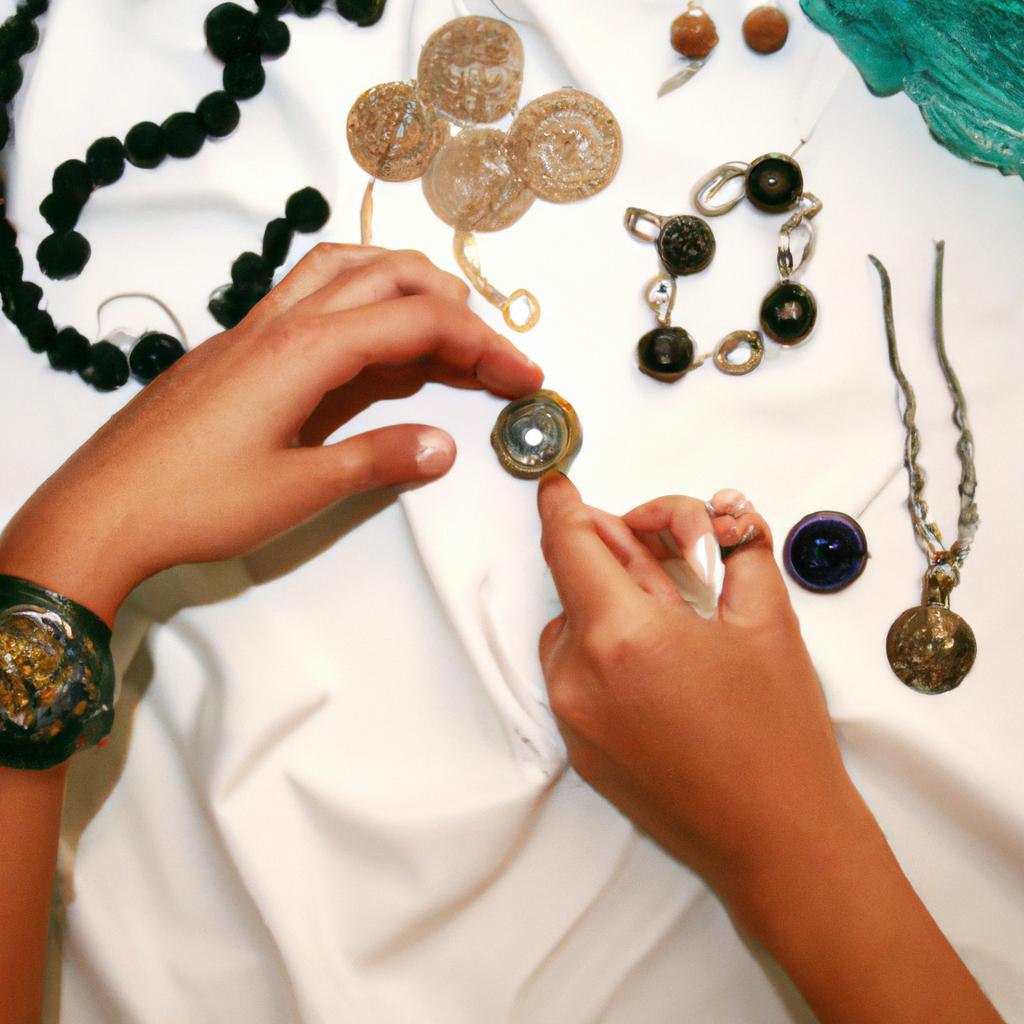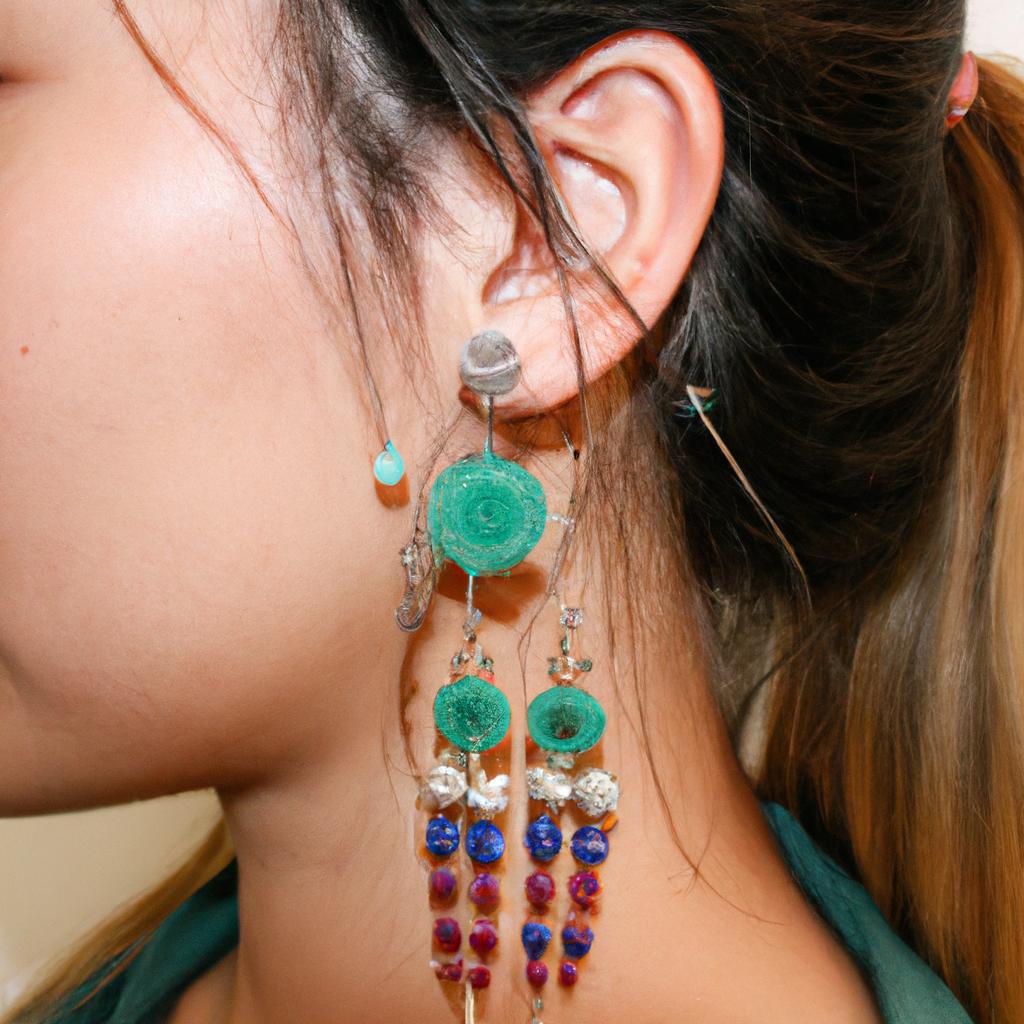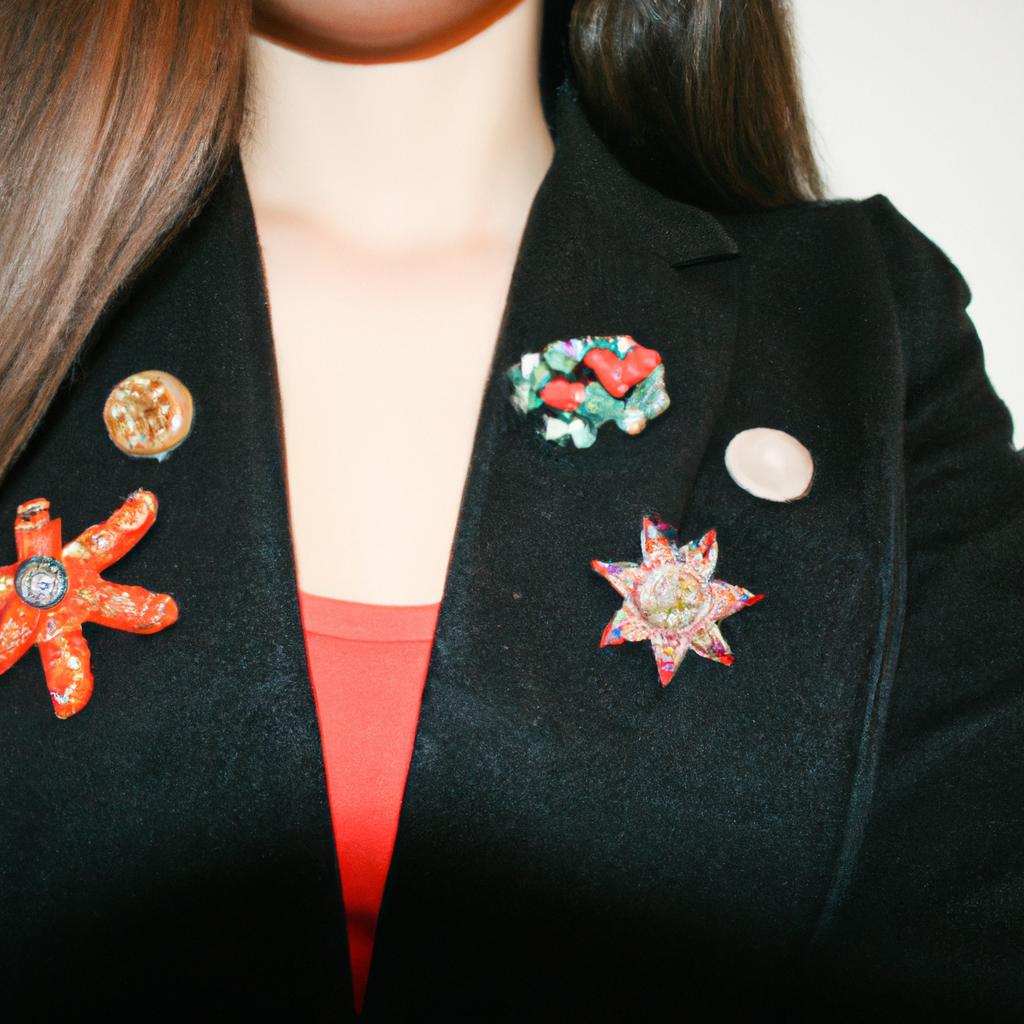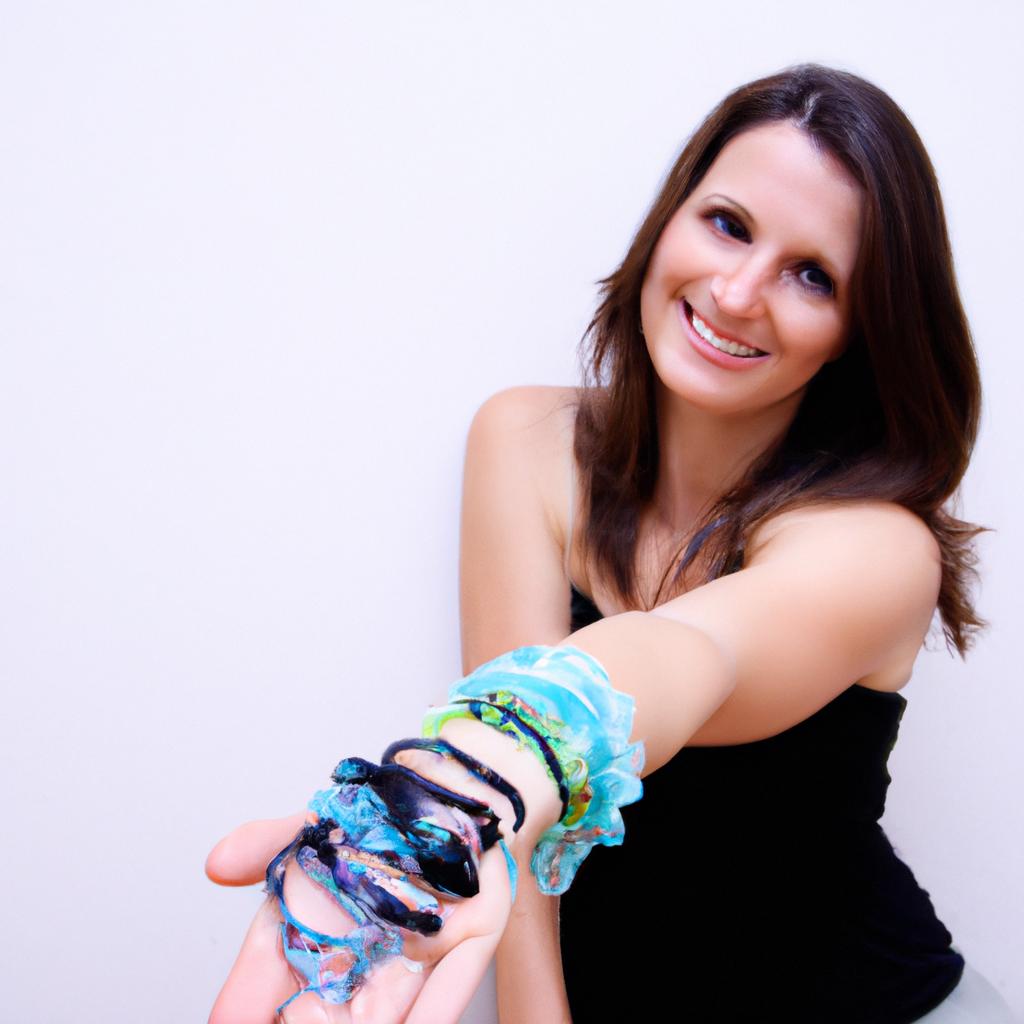The allure of necklaces transcends time and culture, captivating individuals with their exquisite beauty and intricate designs. From the ancient civilizations that adorned themselves in precious metals and gemstones to the contemporary fashionistas who seek statement pieces to complete their ensembles, necklaces have always been a symbol of elegance and grace. This article delves into the enchanting world of necklaces, exploring their historical significance, diverse styles, and the artistry involved in creating these timeless treasures.
Consider the case of Marie, an ardent lover of jewelry who recently inherited a stunning diamond necklace from her grandmother. Intrigued by its exceptional craftsmanship and radiant brilliance, she embarked on a quest to unravel the mysteries behind this heirloom piece. Little did she know that her journey would unearth a fascinating tapestry of cultural symbolism, craftsmanship techniques spanning centuries, and the influence of evolving societal trends on necklace design.
In order to fully appreciate the magic woven within each necklace’s strands, it is crucial to delve into their rich history. Throughout different eras and regions, necklaces have held significant meaning beyond mere ornamentation. They were worn as symbols of wealth or status, expressions of religious devotion or protection against evil spirits. Studying these contexts allows us to unlock the hidden stories embodied by each necklace.
For example, in ancient Egypt, necklaces held a sacred significance and were often worn as amulets for protection and good luck. The use of materials such as gold and precious gemstones reflected the wearer’s social status and connection to the divine. In contrast, during the Victorian era, sentimentalism played a crucial role in necklace design. Lockets containing miniature portraits or hidden compartments holding locks of hair became popular, representing love, remembrance, and personal connections.
The craftsmanship involved in creating necklaces is an art form in itself. From intricate metalwork to delicate beadwork, each style showcases the skill and creativity of its maker. Techniques such as filigree, where thin wires are twisted and shaped into intricate patterns, or granulation, where tiny granules of metal are meticulously soldered onto a base surface, reveal the dedication and precision required to craft these pieces.
Contemporary fashion has also made its mark on necklace design. Statement necklaces adorned with oversized pendants or layers of chunky beads have become popular accessories that can transform any outfit into a fashion statement. Minimalist styles featuring sleek lines and geometric shapes cater to those seeking understated elegance.
As Marie delves deeper into her journey to uncover the secrets of her inherited diamond necklace, she discovers how societal trends have influenced its design over time. From Art Deco-inspired geometric patterns to nature-inspired motifs reflecting the rise of environmental consciousness, it becomes evident that necklaces not only reflect individual taste but also mirror broader cultural shifts.
In conclusion, necklaces hold an enduring allure that transcends time and culture. Their historical significance, diverse styles, and exquisite craftsmanship make them true works of art. Whether passed down through generations or purchased as a modern-day accessory, each necklace tells a unique story that captivates both the wearer and those who behold its beauty. Through their exploration of symbolism, technique, and evolving trends, individuals like Marie gain a deeper appreciation for the enchanting world of necklaces and the magic they hold within their shimmering strands.
The History of Necklaces
Unlocking Elegance: Decoding the Enchanting World of Necklaces
The History of Necklaces
Imagine a bustling marketplace in ancient Egypt, where merchants display their finest goods. Among them, a jeweler proudly presents an exquisite necklace adorned with lustrous pearls and shimmering gemstones. This captivating piece is not just a mere accessory; it holds cultural significance and reflects the wearer’s social status. Throughout history, necklaces have played a crucial role in human adornment, symbolizing power, spirituality, love, and personal expression.
Necklaces date back thousands of years to prehistoric times when humans first discovered ways to fashion materials into wearable art. Archaeological evidence reveals that early necklaces were crafted from shells, bones, animal teeth, or stones. These simple yet meaningful ornaments served as talismans for protection and charms for fertility. As societies evolved and civilizations flourished, so did the complexity and symbolism of necklaces.
To appreciate the evolution of necklaces further, let us explore their historical timeline:
- Ancient Civilizations – In Mesopotamia and Ancient Egypt, elaborate collars made from precious metals such as gold were reserved for royalty and high-ranking officials.
- Greco-Roman Era – The Greeks introduced intricate designs featuring mythological motifs like serpents or gods’ faces on pendants hanging from chains.
- Medieval Period – During this time, religious symbols gained prominence in necklace design as Christianity spread across Europe.
- Renaissance and Beyond – Renaissance artists created breathtakingly detailed jewelry pieces using enameling techniques and incorporating gemstones like diamonds.
Table: Examples of Historical Necklace Styles
| Time Period | Necklace Style |
|---|---|
| Ancient Egypt | Collar-style necklaces with precious metals |
| Greco-Roman Era | Pendants depicting deities or mythological creatures |
| Medieval Period | Crosses and other religious symbols |
| Renaissance and beyond | Intricate designs with gemstones and enameling techniques |
The rich history of necklaces tells a story of human ingenuity, creativity, and cultural diversity. They have transcended time, adapting to changing trends while maintaining their allure. From ancient civilizations to modern times, necklaces continue to be treasured accessories that enhance both personal style and societal standing.
Transitioning seamlessly into the next section about “Types of Necklace Chains,” we delve deeper into the intricate details that differentiate various necklace styles throughout history.
Types of Necklace Chains
Unlocking Elegance: Decoding the Enchanting World of Necklaces
Section H2: Types of Necklace Chains
Having explored the rich history behind necklaces, we now turn our attention to the various types of necklace chains that add a touch of sophistication and allure to these exquisite pieces. From delicate strands to bold links, each type of chain presents unique qualities that enhance the overall aesthetic appeal. Let us delve into this diverse world of necklace chains with an example.
Example:
Imagine you are attending a black-tie event, adorned in a breathtaking evening gown. To complement your attire, you choose to wear a statement piece—a luxurious opera-length necklace with a sleek and elegant cable chain. The elongated chain gracefully drapes around your neckline, exuding timeless beauty and creating an air of intrigue.
Types of Necklace Chains:
- Cable Chain: A classic choice for everyday wear, the cable chain features symmetrical oval or round links interconnected in a uniform manner. Its simplicity allows it to effortlessly blend with any outfit while providing durability and strength.
- Rolo Chain: Known for its rounded links that resemble tiny rings, the rolo chain offers versatility and visual interest. This style can be worn on its own as a dainty accessory or layered with other necklaces for a trendy look.
- Figaro Chain: Exhibiting alternating long and short links in a distinct pattern, the figaro chain stands out due to its eye-catching design. It adds texture and dimension to any ensemble, making it suitable for both casual and formal occasions.
- Snake Chain: Characterized by tightly linked segments resembling snake scales, this type of chain boasts a smooth surface that glides seamlessly against the skin. With its captivating appearance and flexibility, it is often chosen for intricate pendant designs.
Emotional bullet-point list:
- Enhances confidence through self-expression
- Evokes sentimental value with personalized pendants
- Elevates the elegance of any outfit
- Creates a sense of belonging and connection when shared as a gift
Table showcasing necklace chain types:
| Chain Type | Characteristics | Suitable Occasions |
|---|---|---|
| Cable | Symmetrical links, durable | Everyday wear |
| Rolo | Rounded links, versatile | Layering or dainty look |
| Figaro | Alternating long and short links | Casual or formal events |
| Snake | Smooth surface, flexible | Intricate pendant designs |
As we explore the diverse world of necklace chains, it becomes evident that these intricate pieces hold immense emotional significance. Whether enhancing our confidence through self-expression or symbolizing cherished memories with personalized pendants, necklaces have an unparalleled ability to captivate hearts.
Now that we have examined the different types of necklace chains, let us delve into the fascinating realm of materials used in necklace making. From precious gemstones to lustrous metals, each material brings its own unique allure to these exquisite adornments.
Materials Used in Necklace Making
Unlocking Elegance: Decoding the Enchanting World of Necklaces
Types of Necklace Chains have been explored in detail, providing insight into various styles and designs that add a touch of sophistication to any ensemble. Now, let us delve further into the Materials Used in Necklace Making, as they play a crucial role in determining the overall aesthetic appeal and durability of these exquisite pieces.
One fascinating example illustrating the significance of materials is the comparison between two necklaces made with different metals. Consider a necklace crafted from sterling silver versus one made from 14-karat gold. While both may appear visually stunning, their properties differ significantly. The sterling silver necklace showcases a lustrous shine at an affordable price point, making it accessible to a wider range of individuals seeking elegance without breaking the bank. On the other hand, the 14-karat gold necklace exudes opulence and prestige due to its inherent value and timeless allure.
When exploring materials used in necklace making, it is essential to consider not only their visual impact but also their texture, weight, and versatility. Here are four key points to keep in mind:
- Material Durability: Opt for materials like stainless steel or platinum if you desire a long-lasting piece that can withstand daily wear.
- Hypoallergenic Options: For those with sensitive skin or allergies, choose materials such as titanium or niobium known for their hypoallergenic properties.
- Eco-friendly Alternatives: Sustainable options like recycled metals or ethically sourced gemstones contribute positively towards environmental conservation efforts.
- Unique Characteristics: Some materials possess distinctive qualities; for instance, leather necklaces offer a rugged charm perfect for casual outfits or bohemian-inspired looks.
To further illustrate the diversity among necklace-making materials, we present this table showcasing popular choices alongside their notable features:
| Material | Notable Features |
|---|---|
| Sterling Silver | Versatile and affordable with a lustrous shine. |
| 14-karat Gold | Exudes opulence and timeless allure. |
| Stainless Steel | Durable, resistant to tarnishing, ideal for everyday wear. |
| Leather | Offers a rugged charm; suitable for casual or bohemian-inspired outfits. |
As we explore the intricate world of necklace making, it becomes evident that each material choice contributes its unique character to these wearable works of art.
Transitioning seamlessly into the subsequent section on Popular Necklace Pendant Designs, we continue our journey through the captivating realm of necklaces, where pendant designs take center stage. Understanding the materials used lays a solid foundation to appreciate the myriad possibilities in necklace creation.
Popular Necklace Pendant Designs
Unlocking Elegance: Decoding the Enchanting World of Necklaces
Previous section H2: Materials Used in Necklace Making
Unique Transition: As we delve further into the intricate realm of necklace making, it becomes evident that the choice of pendant design plays a vital role in enhancing the overall allure and charm of these exquisite pieces. From simple and understated to ornate and extravagant, there is an abundance of pendant designs available to cater to every individual’s taste. Let us now explore some popular necklace pendant designs that have captivated jewelry enthusiasts worldwide.
Popular Necklace Pendant Designs
Pendant designs serve as focal points on necklaces, adding personality and elegance to any ensemble. To illustrate their significance, let us consider a case study involving Anna, who attends a formal event wearing a delicate silver chain adorned with a shimmering diamond solitaire pendant. The simplicity and sophistication of this classic design effortlessly elevate her outfit, exuding timeless beauty and refinement.
To ignite your imagination further, here are four enchanting pendant designs currently captivating individuals seeking unique adornments:
- Nature-Inspired Pendants: Drawing inspiration from flora and fauna, these pendants showcase intricately crafted leaves, flowers, or animal motifs. They bring a touch of natural splendor to any attire.
- Geometric Pendants: With clean lines and precise shapes like triangles or squares, geometric pendants offer a contemporary twist suitable for modern fashionistas seeking minimalist yet eye-catching accessories.
- Vintage-Inspired Pendants: These nostalgic treasures pay homage to bygone eras through intricate detailing reminiscent of Art Nouveau or Victorian styles. Vintage-inspired pendants evoke sentimentality while adding vintage flair.
- Symbolic Pendants: Infused with meaning and symbolism, such pendants often feature religious symbols, astrological signs, or talismans believed to bring luck or protection.
Now let us examine how different materials complement these pendant designs by exploring their characteristics and properties in the upcoming section, “Materials for Necklace Chains.”
| Pendant Design | Description |
|---|---|
| Nature-Inspired | Delicate leaves, flowers, or animal motifs that bring a touch of natural splendor to any attire. |
| Geometric | Clean lines and precise shapes like triangles or squares suitable for modern fashionistas seeking minimalist accessories. |
| Vintage-Inspired | Nostalgic treasures with intricate detailing reminiscent of Art Nouveau or Victorian styles. |
| Symbolic | Infused with meaning and symbolism such as religious symbols, astrological signs, or talismans believed to bring luck. |
In conclusion, selecting the right pendant design is crucial when curating an exquisite necklace collection. Each design possesses its own unique charm and adds character to various outfits and occasions. As we now understand the significance of pendant designs, let us explore another intriguing aspect – different necklace lengths and styles – which further contribute to crafting elegant ensembles.
Transition into Next Section (“Necklace Lengths and Styles”): Moving forward from pendant designs, understanding how different necklace lengths and styles can enhance one’s personal style becomes paramount in unlocking the full potential of these alluring adornments. Let us now embark on this enlightening journey by examining their distinct features and applications.
Necklace Lengths and Styles
Unlocking Elegance: Decoding the Enchanting World of Necklaces
As we delve deeper into the captivating realm of necklaces, it is essential to understand the various lengths and styles that contribute to their overall allure. By exploring these aspects, one can unlock a plethora of possibilities for personal adornment. Let us begin by examining some popular necklace lengths.
Necklace length plays a vital role in determining how a piece sits on the wearer’s neckline and chest. For example, choker-length necklaces are designed to rest snugly around the base of the throat, accentuating its gracefulness. On the other hand, princess-length necklaces typically measure between 17-19 inches long and sit elegantly along the collarbone, making them versatile options suitable for both casual and formal occasions.
Furthermore, necklace styles further enhance the visual impact of each design. From delicate pendants suspended on dainty chains to bold statement pieces adorned with gemstones or intricate patterns, every style offers a unique expression of elegance. Considerations such as materials used (e.g., gold, silver, pearls) and motifs employed (e.g., nature-inspired designs, geometric shapes) enable individuals to select necklaces that align with their personality and desired aesthetic.
To evoke an emotional response from our readership about this enchanting array of options available within necklace lengths and styles, let us consider the following:
- A petite woman donning a princess-length necklace adorned with sparkling diamonds experiences a sense of confidence and empowerment.
- An artist seeking inspiration finds solace in wearing a pendant featuring an intricately crafted brushstroke motif.
- The timeless elegance exuded by a pearl strand necklace evokes feelings of sophistication and refinement.
- A bohemian spirit revels in adorning themselves with layered necklaces composed of vibrant gemstone beads.
In addition to understanding necklace lengths and styles conceptually, it can be helpful to visualize the information in a concise and organized format. The table below provides an overview of some common necklace lengths, their corresponding styles, and suitable occasions to wear them:
| Necklace Length | Style | Occasion |
|---|---|---|
| Choker | Delicate pendant | Evening events |
| Princess | Statement piece | Formal gatherings |
| Matinee | Layered chains | Casual outings or business attire |
| Opera | Pearl strand | Cultural events or weddings |
By exploring these various necklace options, individuals can embark on a journey of self-expression through elegant adornment. In our subsequent section about “Tips for Choosing the Perfect Necklace,” we will further delve into practical considerations that aid in finding the ideal piece to enhance one’s appearance effortlessly.
Tips for Choosing the Perfect Necklace
Unlocking Elegance: Decoding the Enchanting World of Necklaces
Necklace Lengths and Styles have a significant impact on the overall look and feel of an ensemble. However, it is equally important to consider certain factors when selecting a necklace that perfectly complements your style and enhances your attire. By keeping these tips in mind, you can choose the perfect necklace effortlessly.
One key aspect to consider is the neckline of your outfit. For example, if you are wearing a dress with a plunging V-neckline, a pendant necklace that falls just above the cleavage can add an elegant touch without overpowering the outfit. On the other hand, for high necklines or collared shirts, longer necklaces like opera or rope styles create a visually elongating effect.
Another factor to bear in mind is personal preference. Some individuals prefer delicate and understated designs, while others gravitate towards bold statement pieces that make heads turn. By understanding your own style preferences, you can ensure that the necklace you choose resonates with your personality and makes you feel confident.
To further guide you in selecting the ideal necklace, here are some additional considerations:
- Consider the occasion: Different occasions call for different types of necklaces. A simple chain necklace may be suitable for everyday wear, whereas special events may warrant more elaborate designs.
- Match colors thoughtfully: Choose complementary colors between your necklace and clothing to create a cohesive look. Contrasting colors can also add visual interest.
- Pay attention to proportions: If you have a petite frame, opt for smaller-sized pendants and shorter chains to maintain balance. Conversely, those with larger body frames may find chunkier necklaces or longer strands more flattering.
- Experiment with layering: Layering multiple necklaces can create unique looks by combining different lengths and styles. This technique allows for versatility in accessorizing various outfits.
Consider this hypothetical scenario: Sarah has been invited to attend a formal gala. She decides to wear a strapless, floor-length gown in royal blue. To complement the neckline of her dress and add an element of sophistication, Sarah chooses a choker-style necklace with a sparkling pendant that cascades down to her décolletage.
In addition to these considerations, it can be helpful to refer to the following table for an overview of different necklace lengths commonly used:
| Necklace Length | Description |
|---|---|
| Choker | Sits tightly around the neck |
| Princess | Hangs just below the collarbone |
| Matinee | Falls at or slightly above the bust line |
| Opera | Reaches the middle of the chest or lower |
By thoughtfully considering factors such as outfit necklines, personal style preferences, occasion appropriateness, color matching, proportions, and layering techniques, you can confidently select the perfect necklace that complements your attire while reflecting your unique personality.
Unlocking Elegance: Decoding the Enchanting World of Necklaces continues with ‘Tips for Choosing the Perfect Necklace,’ where additional insights will be shared on selecting necklaces based on face shapes and materials.
 Shanes Jewelry
Shanes Jewelry



